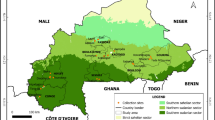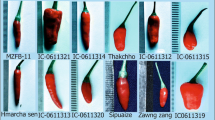Abstract
Groundnut (Arachis hypogaea L.) is an important oilseed crop cultivated in 96 countries of world.World crop productivity (1.30 t ha−1) is low. The available large variability contained in the germplasm accessions has not been adequately utilized in the crop improvement programs and most groundnut cultivars stand on a very narrow genetic base. This is due to lack of information on agronomic and other economic traits, which require extensive evaluation. The development of a core collection could facilitate easier access to groundnut genetic resources, enhance their use in crop improvement programs, and simplify the genebank management. This paper describes the development of a core collection from 14310 accessions of groundnut available from ICRISAT genebank. Germplasm accessions were stratified by country of origin within each of six botanical varieties. Data on 14 morphological descriptor traits were used for clustering by Ward's method. From each cluster ≈ 10 percent accessions were randomly selected to constitute a core collection consisting of 1704 accessions. Mean comparisons using 't' test and distribution using chi-square test and Wilcoxon's rank-sum non-parametric test on different descriptors indicated that the genetic variation available for these traits in the entire collection has been preserved in the core collection. The Shannon-Weaver diversity index for different traits was also similar in the entire collection and core collection. The important phenotypic correlations between different traits, which may be under the control of co-adapted gene complexes, were preserved in the core collection. This core collection provides an effective mechanism for the proper exploitation of groundnut germplasm resources for the genetic improvement of this crop.
Similar content being viewed by others
References
Basigalup D.H., Barnes D.K. and Stucker R.E. 1995. Development of a core collection for perennial Medicago plant introductions. Crop Sci. 35: 1163–1168.
Brown A.H.D. 1989a. Core collections: a practical approach to genetic resources management. Genome 31: 818–824.
Brown A.H.D. 1989b.The case for core collections. In: Brown A.H.D., Frankel O.H., Marshall D.R. and Williams J.T. (eds), The use of plant genetic resources. Cambridge Univ. Press, Cambridge, pp. 136–155.
Brown A.H.D., Grace J.P. and Speer S.S. 1987. Designation of a core collection of perennial Glycine. Soybean Genet. Newsl. 14: 59–70.
Cordeiro C.M.T., Morales E.A.V., Ferreira P., Rocha D.M.S., Costa I.R.S., Valois A.C.C. et al. 1995. Towards a Brazilian core collection of cassava. In: Hodgkin T., Brown A.H.D., van Hintum Th.J.L. and Morales B.A.V. (eds), Core collections of plant genetic resources. International Plant Genetic Resources Institute (IPGRI), John Wiley & Sons, New York, pp. 155–168.
Diwan N., Bauchan G.R. and McIntosh M.S. 1994. A core collection for the United States annual Medicago germplasm collection. Crop Sci. 34: 279–285.
Dussert S., Chabrillange N., Anthony F., Engelmann F., Recalt C. and Hamon S. 1997. Variability in storage response within a coffee (Coffea spp.) core collection under slow growth conditions. Plant Cell Rep. 16: 344–348.
Dwivedi, S.L., Gurtu S., Chandra S., Upadhyaya H.D. and Nigam S.N. 2001. Assessment of genetic diversity among selected rosette virus resistant groundnut (Arachis hypogaea L.) germplasm. II. RAPD, AFLP, and phenotypic diversity. Unpublished.
Erskine W. and Muehlbauer F.J. 1991. Allozyme and morphological variability, outcrossing rate and core collection formation in lentil germplasm. Theor. Appl. Genet. 83: 119–125.
Frankel O.H. 1984. Genetic perspective of germplasm conservation. In: Arber W., Llimensee K., Peacock W.J. and Starlinger P. (eds), Genetic manipulations: impact on man and society. Cambridge University Press, Cambridge, pp. 161–170.
Frankel O.H. and Brown A.H.D. 1984. Current plant genetic resources–a critical appraisal. In: Chopra V.L., Joshi B.C., Sharma R.P. and Bansal H.C. (eds), Genetics: new frontiers Vol. IV. Oxford & IBH Publ. Co., New Delhi, pp. p. 1–13.
Food and Agriculture Organization of the United Nations 1998. Production Yearbook 52: 103–104.
Hannan R.M., Kaiser W.J. and Muehlbauer F.J. 1994. Development and utilization of the USDA chickpea germplasm core collection. In: Agronomy Abstracts 1994. ASA, Madison, WI p. 217.
Halward T.M., Stalker H.T., Larue E.A. and Kochert G. 1991. Genetic variation detectable with molecular markers among unadapted germ-;plasm resources of cultivated peanut and related wild species. Genome 34: 1013–1020.
Halward T.M., Stalker H.T., Larue E.A. and Kochert G. 1992. Use of single-;primer DNA amplification in genetic studies of peanut (Arachis hypogaea L.). Plant Mol. Biol. 18: 315–325.
Halward T.M. and Wynne J.C. 1991. Generation means analysis for productivity in two diverse peanut crosses. Theor. Appl. Genet. 82: 784–792.
He G. and Prakash C.S. 1997. Identification of polymorphic DNA markers in cultivated peanut (Arachis hypogaea L.). Euphytica 97: 143–149.
Holbrook C.C., Anderson W.F. and Pittman R.N. 1993. Selection of core collection from the U.S. germplasm collection of peanut. Crop Sci. 33: 859–861.
Hopkins M.S., Casa A.M., Wang T., Mtchell S.E., Dean R.E., Kochert G.D. et al. 1999. Discovery and characterization of polymorphic simple sequence repeats (SSRs) in peanut. Crop Sci. 39: 1243–1247.
Huaman Z., Aguilar C. and Ortiz R. 1999. Selecting a Peruvian sweet potato core collection on the basis of morphological, ecogeographical, and disease and pest reaction data. Theor. Appl. Genet. 98: 840–844.
IBPGR & ICRISAT (1992). Descriptors for groundnut. Int. Board of Plant Genetic Resources, Rome, Italy, and Int. Crops Res. Inst. For the Semi-;Arid Tropics, Patancheru, A.P., India
Jiang H.F. and Duan N.X. 1998. Utilization of groundnut germ-;plasm resources in breeding programs. Crop Genetic Resources 2: 24–25.
Knauft D.A. and Gorbet D.W. 1989. Genetic diversity among peanut cultivars. Crop Sci. 29: 1417–1422.
Knupffer H. and van Hintum Th.J.L. 1995. The barley core collection: an international effort. In: Hodgkin T., Brown A.H.D., van Hintum Th.J.L. and Morales B.A.V. (eds), Core collections of plant genetic resources. International Plant Genetic Resources Institute (IPGRI), John Wiley & Sons, New York, pp. 171–178.
Kochert G., Halward T., Branch W.D. and Simpson C.E. 1991. RFLP variability in peanut (Arachis hypogaea L.) cultivars and wild species. Theor. Appl. Genet. 81: 565–570.
Kochert G., Stalker H.T., Gimenes M., Galgaro L., Romero Lopes C. and Moore K. 1996. RFLP and cytogenetic evidence on the origin and evolution of allotetraploid domesticated peanut, Arachis hypogaea (Leguminosae). Am. J. Bot. 83: 1282–1291.
Krapovickas A. and Gregory W.C. 1994. Taxonomia del genero Arachis (Leguminosae). Bonplandia VIII: 1–187.
Mahajan R.K., Bisht I.S., Agrawal R.C. and Rana R.S. 1996. Studies on south Asian okra collection: a methodology for establishing a representative core set using characterization data. Genet. Resour. Crop Evol. 43: 244–255.
Milligan G.W. and Cooper M. 1985. An examination of procedures for determining the number of clusters in a data set. Psychometrika. 50: 159–179.
Mixon A.C. and Rogers K.M. 1973. Peanut accessions resistant to seed infection by Aspergillus flavus. Agron. J. 65: 560–562.
Ortiz R., Ruiz-;Tapia E.N. and Mujica-;Sanchez A. 1998. Sampling strategy for a core collection of Peruvian quinoa germplasm. Theor. Appl. Genet. 96: 475–483.
Paik-;Rao O.G., Smith R.L. and Knauft D.A. 1992. Restriction fragment length polymorphism evaluation of 6 peanut species within the Arachis section. Theor. Appl. Genet. 84: 201–208.
SAS Institute 1989. SAS/STAT User' Guide Version 6, 4th edn. SAS Institute, Inc., Cary, NC.
Shannon C.E. and Weaver W. 1949. The mathematical theory of communication. Univ. Illinois Press, Urbana.
Singh A.K. and Simpson C.E. 1994. Biosystematics and genetic resources. In: Smartt J. (ed.), The groundnut crop: a scientific basis for improvement. Chapman & Hall, London, pp. 96–137.
Singh A.K. and Nigam S.N. 1997. Groundnut. In: Fuccillo D., Sears L. and Stapleton P. (eds), Biodiversity in trust–conservation and use of plant genetic resources in CGIAR centers. Cambridge Univ. Press, Cambridge, pp. 114–128.
Skinner D.Z., Bauchan G.R., Auricht G. and Hughes S. 1999. A method for the efficient management and utilization of large germplasm collections. Crop Sci. 39: 1237–1242.
Snedecor G.W. and Cochran W.G. 1980. Statistical methods. 7th edn. Iowa State Univ. Press, Ames.
Subramanian V., Gurtu S., Nageswara Rao R.C. and Nigam S.N. 2000. Identification of DNA polymorphism in cultivated ground-;nut using random amplified polymorphic DNA (RAPD) assay. Genome 43: 656–660.
Tohme J., Jones P., Beebe S. and Iwanaga M. 1995. The combined use of agroecological and characterisation data to establish the CIAT Phaseolus vulgaris core collection. In: Hodgkin T., Brown A.H.D., van Hintum Th.J.L. and Morales B.A.V. (eds), Core collections of plant genetic resources. International Plant Genetic Resources Institute (IPGRI), John Wiley & Sons, New York, pp. 95–108.
Upadhyaya H.D., Bramel P.J. and Singh S. 2001. Development of a chick pea core subset using geographic distribution and quantitative traits. Crop Sci. 41: 206–210.
Ward J. 1963. Hierarchical grouping to optimize an objective function. J. Am. Stat. Assoc. 38: 236–244.
Wilcoxon F. 1945. Individual comparisons by ranking methods. Biometrics Bull. 1: 80–83.
Author information
Authors and Affiliations
Rights and permissions
About this article
Cite this article
Upadhyaya, H.D., Ortiz, R., Bramel, P.J. et al. Development of a groundnut core collection using taxonomical, geographical and morphological descriptors. Genetic Resources and Crop Evolution 50, 139–148 (2003). https://doi.org/10.1023/A:1022945715628
Issue Date:
DOI: https://doi.org/10.1023/A:1022945715628




